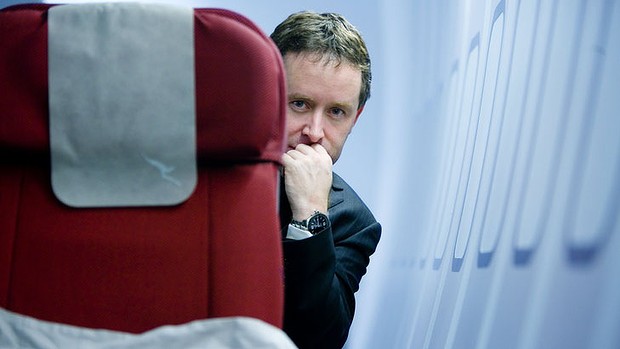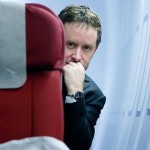
Qantas hasn’t fared well in the last decade. In February 2004 they announced a half-year profit before tax of $530m. A couple of months ago in March 2014, they instead announced a loss of $252m. The Qantas share price has similarly tumbled from $2.62 to $1.23 over the same period.
Back in 2004, when Qantas was under pressure from relatively new entrant Virgin Blue, Qantas’ then-CEO and Managing Director Geoff Dixon spelled out the company’s key goal:
“From what we know of the capacity plans of Virgin Blue and the other domestic carriers over the next two years, and our own plans for capacity increases, the three-product offering of Qantas, Jetstar and QantasLink will have around 65 per cent of the domestic market.
“This is our line in the sand and we will provide the capacity and infrastructure to defend it against Virgin Blue and the other carriers. This is the most profitable course of action for our business.”
After Dixon’s departure in 2008, his replacement Alan Joyce toed the same line, repeating the 65% mantra and building domestic capacity in line with it. Effectively, any time Virgin put on a new flight, Qantas committed themselves to providing two.
In January this year, Gareth Evans, CFO of Qantas, wrote an opinion piece/press release in which he declared that any abandonment of that 65% target would “effectively be waving the white flag…[i]magine someone saying Woolworths should start closing stores in response to the threat from Coles. Anyone who advocates this kind of approach simply does not understand the way business works.”
Now, Qantas has released a statement saying that its capacity growth in the three months starting from July 2014 will be zero. Headlines right now suggest that Qantas is waving the white flag after all.
###
After the collapse of Ansett, Qantas pretty much had a monopoly on domestic air travel in Australia. Virgin Blue changed all that when it showed Australians that they could travel by air at substantially lower cost than what they were used to. Qantas responded by creating Jetstar, following the reasoning that if they didn’t, someone else would. It all seems perfectly reasonable—except that now, ten years after Geoff Dixon drew his “line in the sand”, Qantas has taken its bat and ball and gone home.
With the admitted benefit of hindsight, plenty of commentators now decry Qantas’ decisions over the last decade, but I haven’t seen much in the way of commentary about how Qantas got to that 65% figure in the first place.
The problem is choice
For us here at Change Factory, a strategy (as opposed to a ‘this sounds like a good idea, let’s do it’ plan) has a couple of defining features:
- It has to be selected as the best choice from amongst several good options.
- It needs to define the organisation in some way—to set a sustainable direction that is specific to that organisation at that point in time.
The strategy encapsulated by Qantas’ goal of 65% market share fails dismally on the second one. Saying that you’re going to defend market share is saying you’re going to do whatever it takes to maintain the status quo. And as long as you’re doing that, you’re not innovating, you’re not finding your own voice, your own markets, your own raison d’être. When you’re a follower, by definition you can’t be unique. And when Australia’s pioneering airline becomes a follower, well then everything’s up for grabs.
Take Mr. Evans’ assertion that moving away from the 65% market share figure was analogous to Woolworths closing stores when coming under pressure from Coles. Let’s just turn that analogy around the other way to more accurately reflect what Qantas was doing: would Woolworths open two stores as soon as Coles opened one in a new location? Unlikely. Let’s change the industry: hospitality, perhaps. Would Hyatt open a two new hotels every time a new Sheraton popped up? Probably not.
But let’s move away from industries with significant capital requirements for new startups. What about gyms offering classes? If you’re running a gym with a local competitor, and they put on a new spin class at 6am, do you offer two new spin classes? I doubt it. You might offer one if you weren’t already covering that timeslot, but why would you bother offering two?
By sticking to its 65% capacity mantra, Qantas hobbled itself—it became unable to make choices and instead was forced into actions by its competitors. Unshackling itself from that figure should give Qantas the freedom it needs to make decisions that answer the fundamental question of who Qantas is, and what it means to its prospective customers.
In a straw poll of our office, I asked people what each of Australia’s three major domestic airlines—Jetstar, Virgin, and Qantas—stood for. Who were they?
Jetstar came out as ‘the cheap airline’. Virgin came out as ‘the quirky airline’. And Qantas came out as ‘the other airline you use when you can’t go with Jetstar or Virgin’.
As far as branding goes, that’s pretty woeful. And it all sheets back to this 65% capacity figure. When you look at Qantas’ most recent attempt to update its brand image, what were they trading on? Their uniform, and some market research results. Notice there’s not a single shot of economy class travellers or an economy class cabin in the ad.
Qantas doesn’t appear to have a unique voice, a clear and unambiguous value proposition that it’s willing to stand on. Seemingly, they are flying by the seat of their pants.






